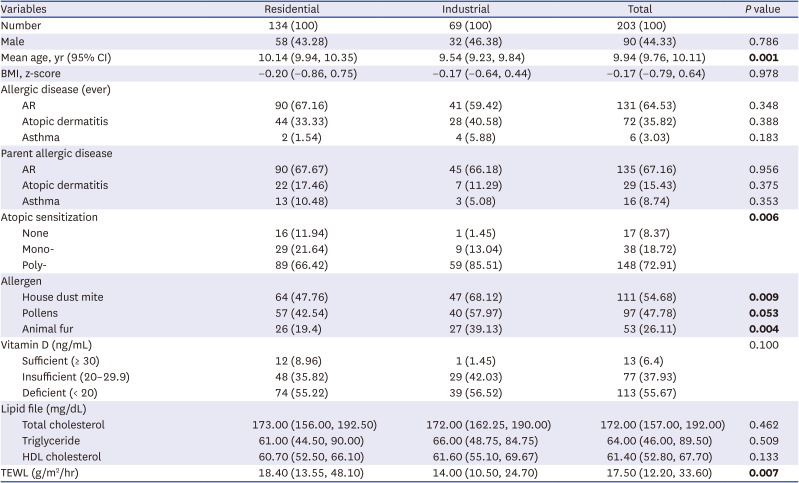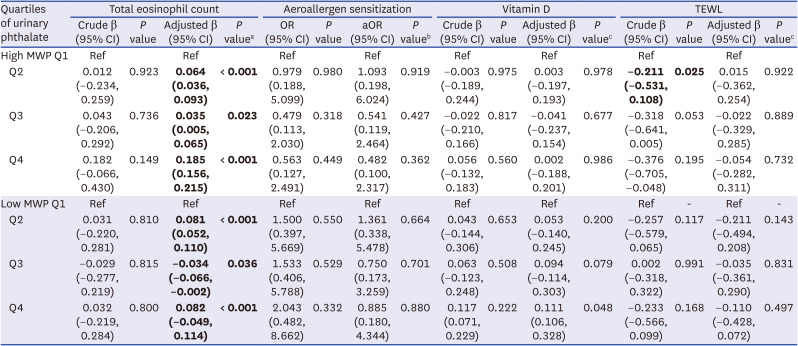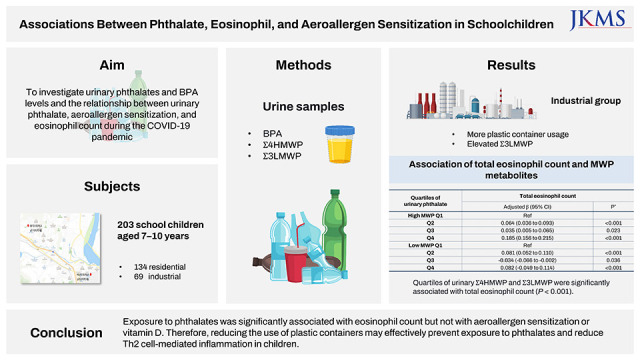1. De Coster S, van Larebeke N. Endocrine-disrupting chemicals: associated disorders and mechanisms of action. J Environ Public Health. 2012; 2012:713696. PMID:
22991565.

2. Kim MA, Yon DK, Jee HM, Kim JH, Park J, Lee SW, et al. Association of phthalates with nasal patency and small airway dysfunction in first-grade elementary school children. Allergy. 2020; 75(11):2967–2969. PMID:
32473031.

3. Ha EK, Kim JH, Park D, Lee E, Lee SW, Jee HM, et al. Personal exposure to total VOC is associated with symptoms of atopic dermatitis in schoolchildren. J Korean Med Sci. 2022; 37(8):e63. PMID:
35226421.

4. Gascon M, Casas M, Morales E, Valvi D, Ballesteros-Gómez A, Luque N, et al. Prenatal exposure to bisphenol A and phthalates and childhood respiratory tract infections and allergy. J Allergy Clin Immunol. 2015; 135(2):370–378. PMID:
25445825.
5. Stelmach I, Majak P, Jerzynska J, Podlecka D, Stelmach W, Polańska K, et al. The effect of prenatal exposure to phthalates on food allergy and early eczema in inner-city children. Allergy Asthma Proc. 2015; 36(4):72–78. PMID:
26108074.

6. Kim JH, Lim JS. Early menarche and its consequence in Korean female: reducing fructose intake could be one solution. Clin Exp Pediatr. 2021; 64(1):12–20. PMID:
32403898.

7. Berger K, Eskenazi B, Balmes J, Kogut K, Holland N, Calafat AM, et al. Prenatal high molecular weight phthalates and bisphenol A, and childhood respiratory and allergic outcomes. Pediatr Allergy Immunol. 2019; 30(1):36–46. PMID:
30338578.

8. Jahreis S, Trump S, Bauer M, Bauer T, Thürmann L, Feltens R, et al. Maternal phthalate exposure promotes allergic airway inflammation over 2 generations through epigenetic modifications. J Allergy Clin Immunol. 2018; 141(2):741–753. PMID:
28392331.

9. Rochester JR. Bisphenol A and human health: a review of the literature. Reprod Toxicol. 2013; 42:132–155. PMID:
23994667.

10. Seachrist DD, Bonk KW, Ho SM, Prins GS, Soto AM, Keri RA. A review of the carcinogenic potential of bisphenol A. Reprod Toxicol. 2016; 59:167–182. PMID:
26493093.

11. Ministry of Food and Drug Safety. Bisphenol A. Updated 2018. Accessed August 31, 2022.
http://www.mfds.go.kr
.
12. Kiguchi T, Yamamoto-Hanada K, Saito-Abe M, Fukuie T, Ohya Y. Eczema phenotypes and IgE component sensitization in adolescents: a population-based birth cohort. Allergol Int. 2023; 72(1):107–115. PMID:
35781407.

13. Pfeffer PE, Hawrylowicz CM. Vitamin D in asthma: mechanisms of action and considerations for clinical trials. Chest. 2018; 153(5):1229–1239. PMID:
28923762.
14. Rafiq R, Thijs W, Prein R, de Jongh RT, Taube C, Hiemstra PS, et al. Associations of serum 25(OH)D concentrations with lung function, airway inflammation and common cold in the general population. Nutrients. 2018; 10(1):35. PMID:
29301349.

15. Lee SI, Shin MH, Lee HB, Lee JS, Son BK, Koh YY, et al. Prevalences of symptoms of asthma and other allergic diseases in Korean children: a nationwide questionnaire survey. J Korean Med Sci. 2001; 16(2):155–164. PMID:
11306740.

16. Lee SJ, Ha EK, Jee HM, Lee KS, Lee SW, Kim MA, et al. Prevalence and risk factors of urticarial with a focus on chronic urticaria in children. Allergy Asthma Immunol Res. 2017; 9(3):212–219. PMID:
28293927.

17. Koch HM, Lorber M, Christensen KLY, Pälmke C, Koslitz S, Brüning T. Identifying sources of phthalate exposure with human biomonitoring: results of a 48h fasting study with urine collection and personal activity patterns. Int J Hyg Environ Health. 2013; 216(6):672–681. PMID:
23333758.

18. Baek HS, Won HY, Kim JH, Ha EK, Jee HM, Shin YH, et al. Association of phthalate exposure and airway dysfunction with mediation by serum periostin. Pediatr Allergy Immunol. 2021; 32(8):1681–1690. PMID:
34291496.

19. Logger JG, Driessen RJ, de Jong EM, van Erp PE. Value of GPSkin for the measurement of skin barrier impairment and for monitoring of rosacea treatment in daily practice. Skin Res Technol. 2021; 27(1):15–23. PMID:
32573826.

20. Kim J, Hahm MI, Lee SY, Kim WK, Chae Y, Park YM, et al. Sensitization to aeroallergens in Korean children: a population-based study in 2010. J Korean Med Sci. 2011; 26(9):1165–1172. PMID:
21935271.

21. Sung M, Yon DK, Lee SW, Kim JH, Baek HS, Jee HM, et al. The relationship between aeroallergen sensitization and chronic cough in school-aged children from general population. Biomed Res Int. 2021; 2021:5513611. PMID:
34840976.

22. Holick MF. Vitamin D deficiency. N Engl J Med. 2007; 357(3):266–281. PMID:
17634462.

23. Sung M, Jee HM, Kim JH, Ha EK, Shin YH, Kim JH, et al. Serum vitamin D level mitigates fractional exhaled nitric oxide linked to bisphenol-A in school-aged children. Eur Rev Med Pharmacol Sci. 2022; 26(5):1640–1647. PMID:
35302211.
24. Schettler T. Human exposure to phthalates via consumer products. Int J Androl. 2006; 29(1):134–139. PMID:
16466533.

25. Baek KM, Seo YK, Baek SO. Occurrence of particulate polycyclic aromatic hydrocarbons and phthalates in the ambient air of Yeosu·Gwangyang Area. J Korean Soc Atmos Environ. 2019; 35(6):767–785.

26. Rapada MZ, Yu DE, Janairo JI, Yu KD. Impact of online-based information and interaction to proenvironmental behavior on plastic pollution. Clean Responsib Consum. 2023; 9:100126.

27. Bekö G, Callesen M, Weschler CJ, Toftum J, Langer S, Sigsgaard T, et al. Phthalate exposure through different pathways and allergic sensitization in preschool children with asthma, allergic rhinoconjunctivitis and atopic dermatitis. Environ Res. 2015; 137:432–439. PMID:
25625823.

28. Bølling AK, Sripada K, Becher R, Bekö G. Phthalate exposure and allergic diseases: Review of epidemiological and experimental evidence. Environ Int. 2020; 139:105706. PMID:
32371302.

29. United States Environmental Protection Agency. Phthalates. Assessing and managing chemicals under TSCA. Updated 2015. Accessed April 7, 2017.
http://www.epa.gov
.
30. Jeon YH, Ahn K, Kim J, Shin M, Hong SJ, Lee SY, et al. Clinical characteristics of atopic dermatitis in Korean school-aged children and adolescents according to onset age and severity. J Korean Med Sci. 2022; 37(4):e30. PMID:
35075829.

31. Sung M, Kim DH, Jee HM, Kim JH, Ha EK, Shin YH, et al. Urine phthalate levels were associated with skin barrier dysfunction and atopic sensitization in children. Eur Rev Med Pharmacol Sci. 2023; 27(7):2888–2898. PMID:
37070889.
32. Overgaard LEK, Main KM, Frederiksen H, Stender S, Szecsi PB, Williams HC, et al. Children with atopic dermatitis and frequent emollient use have increased urinary levels of low-molecular-weight phthalate metabolites and parabens. Allergy. 2017; 72(11):1768–1777. PMID:
28281298.

33. Hu P, Pan C, Su W, Vinturache A, Hu Y, Dong X, et al. Associations between exposure to a mixture of phenols, parabens, and phthalates and sex steroid hormones in children 6–19 years from NHANES, 2013–2016. Sci Total Environ. 2022; 822:153548. PMID:
35114227.












 PDF
PDF Citation
Citation Print
Print





 XML Download
XML Download